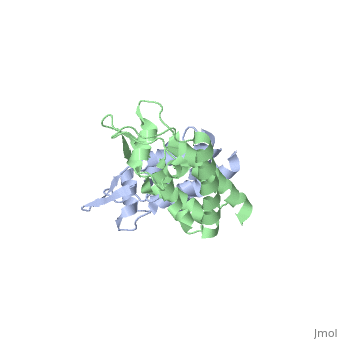Gag polyprotein
From Proteopedia
(Difference between revisions)
| Line 8: | Line 8: | ||
==Capsid (CA) Domain== | ==Capsid (CA) Domain== | ||
| - | Overall, the mature CA<sup>N</sup> domain is very similar in structure to the corresponding domain of the immature Gag<sup>283</sup> polyprotein | + | Overall, the mature CA<sup>N</sup> domain is very similar in structure to the corresponding domain of the immature Gag<sup>283</sup> polyprotein. The CA<sup>N</sup> protein contains 7 α-helices (helix 1-helix 7) that pack together to form a triangular shape, which helps facilitate the final complex formation for the capsid core particles. There are two significant structural differences between the immature and mature versions of the CA<sup>N</sup> domain: an N-terminal β-hairpin and a 2-Angstrom displacement of helix 6. |
In the mature CA<sup>N</sup> protein, the N-terminal residues form an anti-parallel β-hairpin instead of the random coil that is observed when the same residues are compared in the immature Gag<sup>283</sup> polyprotein. The NH<sub>2</sub>+ group of the N-terminus proline establishes a salt bridge with a nearby aspartic acid, which stabilizes the β-hairpin. This N-terminal β-hairpin is required for the final formation of the viral capsid, and many studies have shown through conservation and mutagenesis that this β-hairpin is responsible for the stabilization of the protein complexes involved in the capsid formation <ref name="gitti">PMID:8662505</ref><ref name="von">PMID:9501077</ref>. | In the mature CA<sup>N</sup> protein, the N-terminal residues form an anti-parallel β-hairpin instead of the random coil that is observed when the same residues are compared in the immature Gag<sup>283</sup> polyprotein. The NH<sub>2</sub>+ group of the N-terminus proline establishes a salt bridge with a nearby aspartic acid, which stabilizes the β-hairpin. This N-terminal β-hairpin is required for the final formation of the viral capsid, and many studies have shown through conservation and mutagenesis that this β-hairpin is responsible for the stabilization of the protein complexes involved in the capsid formation <ref name="gitti">PMID:8662505</ref><ref name="von">PMID:9501077</ref>. | ||
Current revision
| |||||||||||
Contents |
Additional Resources
For additional information, see: Human Immunodeficiency Virus
Reference
- ↑ Coffin, J., S. Hughes, and H. Varmus, Retroviruses. 1997: Cold Spring Harbor Laboratory Press.
- ↑ 2.0 2.1 Gitti RK, Lee BM, Walker J, Summers MF, Yoo S, Sundquist WI. Structure of the amino-terminal core domain of the HIV-1 capsid protein. Science. 1996 Jul 12;273(5272):231-5. PMID:8662505
- ↑ 3.0 3.1 von Schwedler UK, Stemmler TL, Klishko VY, Li S, Albertine KH, Davis DR, Sundquist WI. Proteolytic refolding of the HIV-1 capsid protein amino-terminus facilitates viral core assembly. EMBO J. 1998 Mar 16;17(6):1555-68. PMID:9501077 doi:10.1093/emboj/17.6.1555
- ↑ Braaten D, Franke EK, Luban J. Cyclophilin A is required for an early step in the life cycle of human immunodeficiency virus type 1 before the initiation of reverse transcription. J Virol. 1996 Jun;70(6):3551-60. PMID:8648689
- ↑ Thali M, Bukovsky A, Kondo E, Rosenwirth B, Walsh CT, Sodroski J, Gottlinger HG. Functional association of cyclophilin A with HIV-1 virions. Nature. 1994 Nov 24;372(6504):363-5. PMID:7969495 doi:http://dx.doi.org/10.1038/372363a0
- ↑ Ackerson B, Rey O, Canon J, Krogstad P. Cells with high cyclophilin A content support replication of human immunodeficiency virus type 1 Gag mutants with decreased ability to incorporate cyclophilin A. J Virol. 1998 Jan;72(1):303-8. PMID:9420228
Team from University of Missouri, Columbia, MO
- Students: Zheng Wang, Allison Tegge, Xin Deng
- Advisors: Jianlin Cheng, PhD, Department of Computer Science, Informatics Institute, the Life Science Center, Interdisciplinary Plant Group, University of Missouri, Columbia
- Mentor: Chun Tang, PhD, Department of Biochemistry, University of Missouri, Columbia
NMR Equipment and the Authors
Created by Allison Tegge and David Canner






